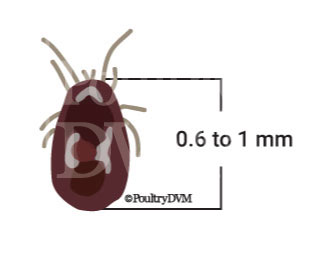Veterinary advice should be sought from your local veterinarian before applying any treatment or vaccine. Not sure who to use? Look up veterinarians who specialize in poultry using our directory listing. Find me a Vet
Other Names: Chicken Mites, Roost Mites, Poultry Red Mites

| Northern fowl mite | Red poultry mite | |
|---|---|---|
| Adult Appearance | ||
| Size | 0.6-1 mm (0.02-0.04 in) | 0.6-1 mm (0.02-0.04 in) |
| Color | Gray to black; red after feeding | Gray to black; red after feeding |
| Visible to the naked eye | As tiny dark specs | As tiny dark specs, must look at night. |
| Feeds on | Blood | Blood |
| Where they live | On the chicken full time, in the vent area | Hide in crevices and cracks during the day, feeds on chickens at night |
| Transmission | Wild birds, rodents, contaminated equipment (fomites) and personnel | Wild birds, rodents, wildlife, dogs, cats, humans, contaminated equipment |
| Where eggs are laid | White to off-white bundles of eggs found along the feather shaft of the vent. | In their hiding spot in the coop |
| Average Life cycle | 5-7 days | 2 weeks |
| How you can tell | Early infestations may be difficult to notice, but once numbers increase they can be clearly seen in the feathers and running along the skin surface. May also be seen on recently laid eggs. Brown, dirty looking debris within feathers. Feathers appear 'dirty'. Surface of the skin is cracked and may bleed. Thickened, inflammation of skin. Eggs and dark excrement near cloaca. | Look for them at night on the birds |
| Temperature | Cool weather | Warm weather |
| Clinical signs | Dermatitis, poor condition (feathers appear 'dirty'), anemia, pale pink comb, soiled feathers near vent | Restlessness at night, dermatitis, anemia, may cause chickens to alter where they roost at night. |
| Zoonotic | Yes | Yes |
| Carry diseases | Yes | Yes |
| Name | Summary | |
|---|---|---|
| Spinosad (Trade name Elector PSP) | Applied as a spray on all coop housing components. | B Mullens et al., 2017; A Murillo et al., 2017; Dow AgroSciences 2001 |
| Fluralaner (trade name Exzolt) | Added to the flock's drinking water. The product is administered twice, 7 days apart so it treats two mite life cycles. There is no egg withdrawal period and trials show it to be 99% effective at killing mites. | N Hinkle, et al 2018; A Prohaczik et al., 2017; B Mullens et al., 2017 |
| Ivermectin | 0.2 mg/kg PO, SC, IM, topical once and repeated in 10-14 days. | B Speer; W Campbell et al., 1984; S Lee et al., 2006 |
| Garlic spray | 10% garlic solution diluted with water, sprayed on the chicken's vent and abdomen, once every 7 days for 3 weeks. | Birrenkott, G. P., et al., 2000 |
| Diatomaceous Earth (DE) (food grade) | Apply by dusting onto the chicken's feathers or added to their dust bathing area. Also dust all housing components. Replace bedding and nesting material. | A Murillo et al., 2016; C Martin et al., 2012; D Bennett et al., 2011, G Damerow |
| Sulfur | Applied as a dust directly on the chickens or added to their dust bathing area. Dust all housing components in coop | A Murillo et al., 2016, G Damerow |
| Malathion | Used as a spray or powder applied to all housing components in coop. | G Damerow |
| Carbaryl synthetic | Applied as a powder (5% carbaryl) or spray (4 ounces of 80% carbaryl mixed in a 5 gallon bucket of water) directly on the chickens as well as all housing components. Replace bedding and nesting material. | G Damerow |
| Pyrethrum | Applied as a powder or a spray on both the chickens as well as all housing components. Bedding and nesting materials should be replaced. When treating the bird, apply directly on the chicken's feathers, concentrating on the vent area. Note that it only kills the adult insects, not the larvae and eggs. Therefore, treatment will need to be repeated. | G Damerow |
| Permethrin | Applied as a powder (0.24% permethrin) or spray (3 ounces of 10% permethrin is mixed in a 5 gallon bucket of water), directly on the chickens as well as all housing components. Replace bedding and nesting material. | G Damerow |
| Thyme essential oil | Applied as a spray directly on the mites | T Smith et al., 2017; F Masoumi et al., 2016; D George et al., 2010; IS Nechita et al., 2015; A.M Quilicot et al., 2020 |
| Hemp essential oil | Applied as a spray directly on the mites | MA Tabari et al., 2020 |
| Ajowan essential oil | Applied as a spray directly on the mites | AI Baran et al., 2020 |
| Garlic extract or essential oils | Applied as a spray directly on the mites. | A.M Quilicot et al., 2020 |
| Syzygium aromaticum essential oil | Applied as a spray directly on the mites. | MA Tabari et al., 2020 |
| Winter | Spring | Summer | Autumn |
© 2025 PoultryDVM All Rights Reserved.